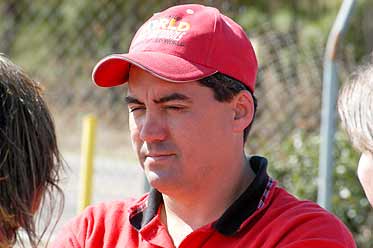
 DRO:
Isn’t it limiting, though, that your cars
are still supposed to at least look streetable
and aren’t supposed to have any advertising
on them? DRO:
Isn’t it limiting, though, that your cars
are still supposed to at least look streetable
and aren’t supposed to have any advertising
on them?
Kirk: Yeah,
but we’re trying to get to where we could
at least put something on the quarter panels.
To me, you’re gonna’ have to have
that because it’s getting so expensive
to do this. You’ve got to have an NHRA-level
pro set-up to do this deal right. If you haven’t
got back-up motors, and back-up transmissions,
and back-up this and that, you’re not gonna’
make it to the finals with any consistency.
Before this year is over, you’ll see people
changing motors between rounds.
DRO: What’s
the level of competition in the class, especially
regarding the quality of drivers?
Kirk: I’ll
tell you what, if you go down and look at the
reaction times and the consistency of these
cars from yesterday and today, you’re going
to find these guys are dead on. I’d put
this whole group of Outlaw 10.5 drivers right
up there with anybody in the pro ranks. I mean,
you can go look at just about anybody’s
ticket and you’ll see a four-oh light,
a four-ten light, or a four-twenty light. And
that’s what it takes to win; there ain’t
nobody givin’ up nothin’ here. Everybody’s
looking for the edge.
DRO: Is it
fun racing, though?
Kirk: Oh yeah,
it’s fun, this is a great bunch of guys
to race with. But it’s a full-time job,
too; we promote our business out of doing this
deal.
DRO: What would
it cost if someone wanted to get into this type
of racing? What would a turn-key operation cost?
Kirk: A competitive
turn-key car is gonna’ run you about $150,000,
and then you’ve got your customer preferences.
So it’s not a cheap class. In the late-‘90s
people were taking older back-halved cars and
putting big cubic-inch motors in there and going
out and running 4.90s, and at that time that
was great. Now, it requires state-of-the-art
chassis and state-of-the-art tune-ups, and there’s
guys out here testing every day of the week
to do this right.
DRO: What does
it take these days to be competitive?
Kirk: You have
to be able to run a 4.68 to a 4.72 with a .420
reaction time and that will get you to the final
round at just about any race.
DRO: What does
this class offer potential sponsors?
Kirk: Well,
just like the pro classes in NHRA and IHRA,
we’ve got the big rigs and they can be
just like a rolling billboard heading down the
highway. We’re out here two or three days
each weekend between testing on Friday, qualifying
Saturday, and racing on Sunday. And
ADVERTISEMENT
 |
we’re
out here every weekend, continuously up and
down the roads, usually two or three days a
week.
DRO: Do you
see this class taking off nationally the way
Pro Mod eventually did, or will it always be
just a popular class at the eighth-mile southeastern
tracks?
Kirk: I think
it will come around. I mean, last year we had
a $20,000-to-win race at Huntsville and we had
56 cars show up. So, that’ll tell you what’s
out there. And there’s talk of an organization
out of Texas that’s basically got the same
style of cars with big tires and they’ve
turned that whole program into a 10-inch tire
deal. So that’s going to really increase
how many cars you can get to these races, especially
later on in the year where there’s larger
payouts.
DRO: What would
you want people to know about your race team?
Kirk: Just
that we’re die-hard racers. It takes a
lot of work and a lot of effort, and my guys
at the shop work 24-hours-a-day, sometimes seven-days-a-week
to get this car ready. Plus, my wife Lynne is
behind me a hundred percent, along with my stepdaughter,
Brooke. We’ve also got two team guys, Michael
Lynch and Ronnie McGibbony, and it takes everybody’s
support to run this operation, no question about
it. 
|